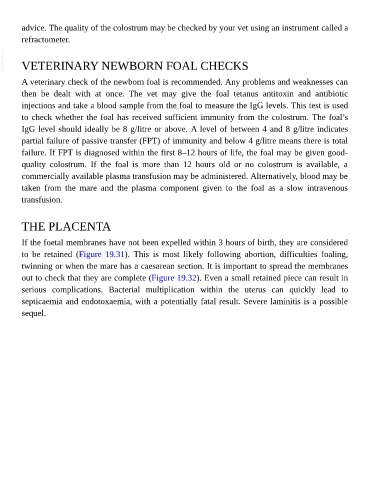Page 960 - The Veterinary Care of the Horse
P. 960
advice. The quality of the colostrum may be checked by your vet using an instrument called a
refractometer.
VetBooks.ir VETERINARY NEWBORN FOAL CHECKS
A veterinary check of the newborn foal is recommended. Any problems and weaknesses can
then be dealt with at once. The vet may give the foal tetanus antitoxin and antibiotic
injections and take a blood sample from the foal to measure the IgG levels. This test is used
to check whether the foal has received sufficient immunity from the colostrum. The foal’s
IgG level should ideally be 8 g/litre or above. A level of between 4 and 8 g/litre indicates
partial failure of passive transfer (FPT) of immunity and below 4 g/litre means there is total
failure. If FPT is diagnosed within the first 8–12 hours of life, the foal may be given good-
quality colostrum. If the foal is more than 12 hours old or no colostrum is available, a
commercially available plasma transfusion may be administered. Alternatively, blood may be
taken from the mare and the plasma component given to the foal as a slow intravenous
transfusion.
THE PLACENTA
If the foetal membranes have not been expelled within 3 hours of birth, they are considered
to be retained (Figure 19.31). This is most likely following abortion, difficulties foaling,
twinning or when the mare has a caesarean section. It is important to spread the membranes
out to check that they are complete (Figure 19.32). Even a small retained piece can result in
serious complications. Bacterial multiplication within the uterus can quickly lead to
septicaemia and endotoxaemia, with a potentially fatal result. Severe laminitis is a possible
sequel.

